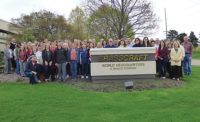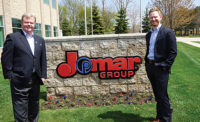Established in 1982, family-owned MIFAB manufactures a host of commercial plumbing products from floor, roof and area drains to grease interceptors to its BEECO line of pressure-reducing valves and backflow preventers. The company started in Toronto, Ontario, Canada, and relocated to its current location in Chicago, which includes a full complement of precision laser cutters and fabrication machinery for custom stainless-steel jobs. President Michael Whiteside and Vice President of Sales and Marketing Hugh Hornsby recently talked to Supply House Times at MIFAB headquarters about a variety of topics including the company’s continued growth, its relationship with distributors and engineers and the release of several new products.
Supply House Times: What product categories are you seeing big growth in right now?
MW: Plastic interceptors definitely are booming. We’re seeing a real market interest shift away from steel to plastic. We manufacture big and little interceptors and those sales are growing. We’ve been in the interceptor business a long time so making the move to plastic was a natural fit. We started at zero a year-and-a-half ago with them and have seen great growth. Couplings are another category that is growing. Every drain typically needs a coupling to connect to the pipe, so again, it’s a natural. Also, our C-Port recycled rubber rooftop supports has been a great product that is getting more and more into wholesale distribution.
Supply House Times: What advantages to you realize from the breadth of products you offer?
MW: We can go to a distributor and say you typically can reduce the number of suppliers by working with us because we cover so many product categories. You can consolidate purchases into one PO. We are an amalgamation of 12 distinct and different lines. When you are with MIFAB you have 12 different manufacturers, given all the products we have.
Supply House Times: With the products you produce how critical is your relationship with engineers and manufacturers reps?
MW: When we hear we need to get into the engineering community to get specified, we need to create the demand. We need the right local reps that have good relationships with distributors. We just picked up five new reps in different markets that have great relationships established and are good at driving demand to the engineer — that creates more distributor demand.
HH: As an example, the drain business is changing and our industry is getting older. There aren’t as many of the traditional drain guys as there used to be. That leaves us an opportunity to retrain the industry. Our regionals can only do so much. I can only do so much and Michael can only do so much.
One of the books we’ve read here is, “Who” (a New York Times Best Seller on hiring practices). You have to find people who know how to do the things you want to do. We’re focused on working with people who are willing to work with us and put a strategy together on what we want do next. We want to get them trained and get training facilities in their place so they can pull in contractors. That’s going to help us. We are evolving into a company that can sell all these products and become leaders and trainers in the marketplace. We’re picking specific reps that will work with us to set up training centers to bring in contractors and start changing MIFAB and changing the industry. We have the team in place to make that happen.
Supply House Times: What recent innovations and advancements have helped the company push forward?
MW: We have a new laser-cutting machine here that was a $500,000 investment. It allows us to cut steel and stainless-steel faster and ship finished interceptors, trench drains and access doors faster.
We’re also moving toward ISO 9001 certification. That’s estimated to go into effect in the third quarter of 2017. That usually takes a year-and-a-half to two years. It certainly is a marketing benefit to say to a distributor customer that we are ISO-certified. It gives them the confidence that we’ve documented procedures and are following them a certain way. For us internally, it tells us we are doing things the right way.
Supply House Times: How do siphonic roof drains factor into the company’s long-range plans?
MW: Siphonic has been in the U.S. about 10 years now. I’m surprised it’s not more common than it is today. We partnered with HydroMax out of Scotland. They are siphonic experts. We see a huge growth opportunity here. There is more and more acceptance by engineers to this technology. We have the right partner, the right software and the right technical support. We are targeting building owners such as Amazon and Costco and other big manufacturer warehouse people. We can show them the value of siphonic and that allows us to go back to wholesalers and create demand.
Supply House Times: How has your commitment to stainless-steel drains played a role in the company’s growth?
MW: When we started in the drain business we had some good competitors. It wasn’t like anybody jumped up and down and said thank goodness there is a new drain company. We had to be different. If we can give customers a heavy-duty stainless-steel drain at no upcharge, that sets us apart and will help the engineering community.
Supply House Times: How important is your relationship with the distribution community?
MW: With the distributors, we focused on less parts and giving them a real gross-margin return-on-investment advantage with our fewer SKUs, fewer dollar inventory and higher margin opportunities. With fewer parts needed the overall cost is less because of our designs. Hugh has a long history with the distribution community, the buying groups and ASA. Our focus in the past may have been more on the contractor and engineer side to build demand around specification. With all our products we have a great opportunity to get closer to the distribution community.
Supply House Times: What new products are on the horizon?
MW: We have two new products coming in the interceptor category. We have a super-large family of plastic interceptors in development that are about a year away. We see more demand at the engineer level to move away from concrete because of the nature of concrete material. The other one is an automatic recovery interceptor. Stainless-steel ones have a wheel that removes the grease as it accumulates. In the long run, we see water conservation and water-quality hitting the treatment plants being a bigger issue and people getting stricter on what can be dumped in the sewer. We think there is a growing demand for interceptors. We want to expand the range and be a one-stop interceptor manufacturer whether it’s plastic or stainless steel. There is no other company that has that complete of an offering.
We’re also working on getting USC approval for our BEECO line. That’s another year-and-a-half before that is complete. That will lead to a big surge in volume because most of the country needs that approval. When that happens, we’ll have to think hard about the physical expansion of our building (MIFAB currently operates out of a 60,000-sq.-ft. building in Chicago and has the ability to expand to 100,000 sq. ft. on the land it owns).
Supply House Times: What advantages are there being a family-owned entity?
MW: The biggest advantage is the long-term view we have. We’ve been in the backflow preventer business eight years. We brought on Paul Lacourciere (former Watts president) to head up backflow and lead our BEECO line. We made a big investment in BEECO that maybe other publically traded companies would look at on a 10-20-year timeline. We have the ability to make long-term investments. We’re not so concerned about the quarter or the year. We take a long-term view on everything.
Supply House Times: Your advice to distributors, engineers and reps?
MW: Stay focused on your customers’ needs. Plastic interceptors are a good example. That’s where things are moving and what people wanted so it made sense to expand. As long as we continue to focus on what people want and respond that way, we will be fine.
This article was originally titled “More is even better” in the November 2016 print edition of Supply House Times.






